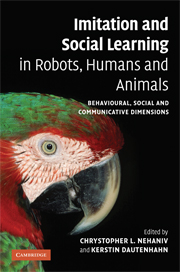Refine listing
Actions for selected content:
1372 results in Ebooks on robotics
5 - Kinematics
-
- Book:
- Robotics for Electronics Manufacturing
- Published online:
- 06 July 2010
- Print publication:
- 06 May 2010, pp 124-153
-
- Chapter
- Export citation
Preface
-
- Book:
- Robotics for Electronics Manufacturing
- Published online:
- 06 July 2010
- Print publication:
- 06 May 2010, pp xi-xii
-
- Chapter
- Export citation
Contents
-
- Book:
- Robotics for Electronics Manufacturing
- Published online:
- 06 July 2010
- Print publication:
- 06 May 2010, pp ix-x
-
- Chapter
- Export citation
Appendix B - Standards organizations
-
- Book:
- Robotics for Electronics Manufacturing
- Published online:
- 06 July 2010
- Print publication:
- 06 May 2010, pp 223-224
-
- Chapter
- Export citation
Index
-
- Book:
- Robotics for Electronics Manufacturing
- Published online:
- 06 July 2010
- Print publication:
- 06 May 2010, pp 232-238
-
- Chapter
- Export citation
1 - Industrial robotics
-
- Book:
- Robotics for Electronics Manufacturing
- Published online:
- 06 July 2010
- Print publication:
- 06 May 2010, pp 1-11
-
- Chapter
- Export citation
Frontmatter
-
- Book:
- Robotics for Electronics Manufacturing
- Published online:
- 06 July 2010
- Print publication:
- 06 May 2010, pp i-viii
-
- Chapter
- Export citation
4 - Design of vacuum robots
-
- Book:
- Robotics for Electronics Manufacturing
- Published online:
- 06 July 2010
- Print publication:
- 06 May 2010, pp 73-123
-
- Chapter
- Export citation
3 - Design of atmospheric robots
-
- Book:
- Robotics for Electronics Manufacturing
- Published online:
- 06 July 2010
- Print publication:
- 06 May 2010, pp 30-72
-
- Chapter
- Export citation
Appendix A - SI units and conversion tables
-
- Book:
- Robotics for Electronics Manufacturing
- Published online:
- 06 July 2010
- Print publication:
- 06 May 2010, pp 220-222
-
- Chapter
- Export citation
2 - Cleanroom robotics
-
- Book:
- Robotics for Electronics Manufacturing
- Published online:
- 06 July 2010
- Print publication:
- 06 May 2010, pp 12-29
-
- Chapter
- Export citation
6 - Dynamics and control
-
- Book:
- Robotics for Electronics Manufacturing
- Published online:
- 06 July 2010
- Print publication:
- 06 May 2010, pp 154-178
-
- Chapter
- Export citation
7 - Test and characterization
-
- Book:
- Robotics for Electronics Manufacturing
- Published online:
- 06 July 2010
- Print publication:
- 06 May 2010, pp 179-219
-
- Chapter
- Export citation

Imitation and Social Learning in Robots, Humans and Animals
- Behavioural, Social and Communicative Dimensions
-
- Published online:
- 10 December 2009
- Print publication:
- 29 March 2007
Frontmatter
-
- Book:
- The Quest for Artificial Intelligence
- Published online:
- 05 August 2013
- Print publication:
- 30 October 2009, pp i-vi
-
- Chapter
- Export citation
26 - Reasoning and Representation
-
- Book:
- The Quest for Artificial Intelligence
- Published online:
- 05 August 2013
- Print publication:
- 30 October 2009, pp 349-364
-
- Chapter
- Export citation
11 - Knowledge Representation and Reasoning
-
- Book:
- The Quest for Artificial Intelligence
- Published online:
- 05 August 2013
- Print publication:
- 30 October 2009, pp 149-161
-
- Chapter
- Export citation
PART I - BEGINNINGS
-
- Book:
- The Quest for Artificial Intelligence
- Published online:
- 05 August 2013
- Print publication:
- 30 October 2009, pp 1-2
-
- Chapter
- Export citation
Index
-
- Book:
- The Quest for Artificial Intelligence
- Published online:
- 05 August 2013
- Print publication:
- 30 October 2009, pp 539-562
-
- Chapter
- Export citation
Contents
-
- Book:
- The Quest for Artificial Intelligence
- Published online:
- 05 August 2013
- Print publication:
- 30 October 2009, pp vii-xii
-
- Chapter
- Export citation
